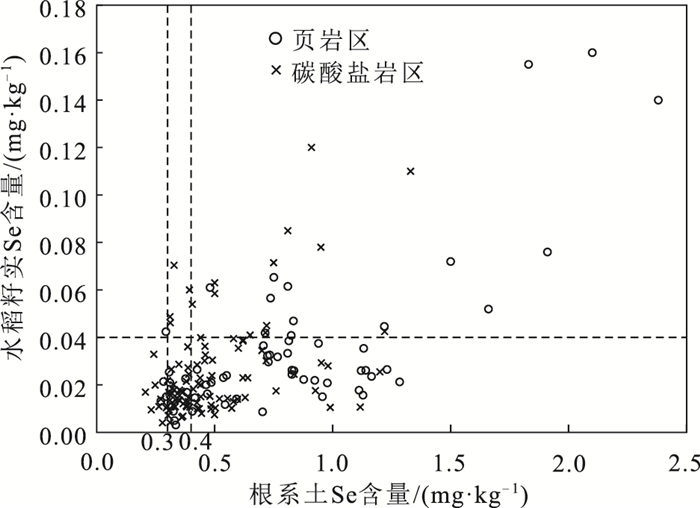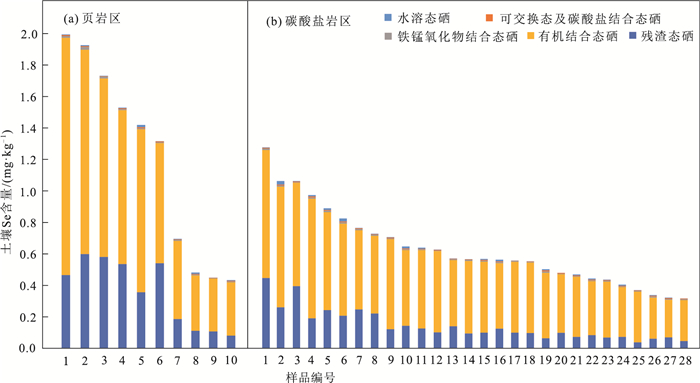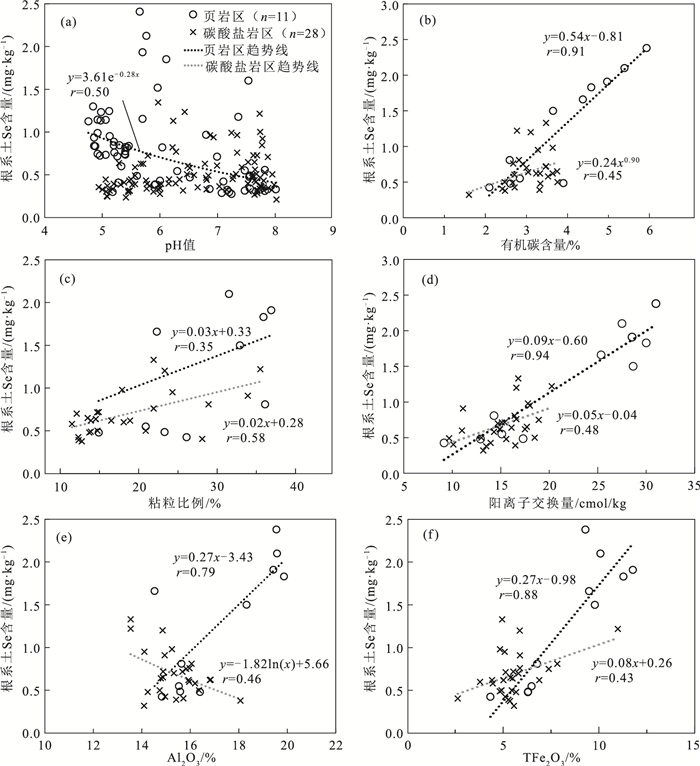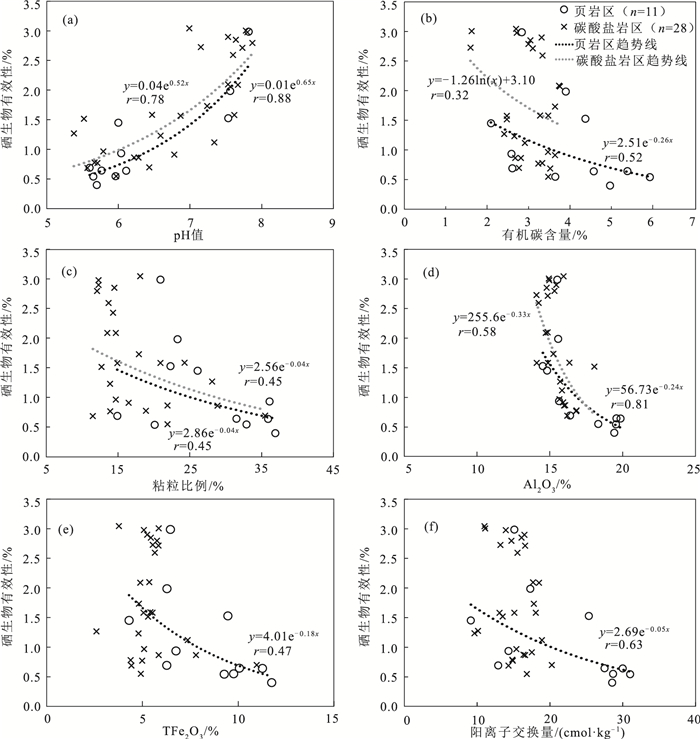Control factors of selenium content and bioavailability of rice root soil in shale and carbonate rock areas, Luzhou City, Sichuan Province
-
摘要:
以四川省泸州市碳酸盐岩和页岩分布区为研究区,开展了Se在成土母岩-根系土-水稻籽实体系中含量特征及迁移规律研究,丰富Se元素迁移转化理论,支撑服务富硒土地开发利用。研究结果表明,研究区页岩、根系土和水稻籽实Se含量分别为0.03~1.97 mg/kg、0.27~2.38 mg/kg和0.02~0.16 mg/kg,土壤硒以有机结合态(73%)和残渣态(25%)为主,有效态硒仅占0.69%。碳酸盐岩、根系土和水稻籽实Se含量分别为0.02~0.12 mg/kg、0.21~1.33 mg/kg和0.02~0.12 mg/kg,明显低于页岩区,土壤中有机结合态和残渣态硒所占比例高达97%,有效硒比例(1.58%)高于页岩区土壤。成土母岩的矿物组成和化学成分、Se含量及赋存形式对土壤性质和Se含量具有一定的控制作用。有机质、粘土矿物和pH值是土壤Se含量和生物有效性的主要控制因素。有机质和粘土矿物对硒的强烈吸附作用是研究区土壤富硒但生物有效性低的主要原因;pH值降低导致土壤胶体对硒的吸附能力升高,使土壤Se含量升高,但硒生物有效性随pH值降低明显降低。综上所述,研究区土壤Se含量高但生物有效性低,因此水稻籽实Se含量并不高,富硒土地的开发利用不能仅以土壤全Se含量作为判别标准,应结合土壤性质及硒生物有效性综合考虑。
Abstract:The control factors of selenium content and migration rule in the parent rock-root soil-rice system in sedimentary rock areas (carbonate rock and shale) were studied to enrich the theory of selenium migration and transformation and further support the scientific utilization of selenium-rich land.The Se values of shale, corresponding soil and rice seed are 0.03~1.97 mg/kg, 0.27~2.38 mg/kg and 0.02~0.16 mg/kg, respectively, and carbonate rock, soil and rice seed show Se content of 0.02~0.12 mg/kg, 0.21~1.33 mg/kg and 0.02~0.12 mg/kg.The proportion of organic binding Se and residual Se in soil is up to 98%.The Se bioavailability of soil in shale area is 0.69%, which is lower than that in carbonate rock area (1.58%).The mineral and chemical compositions as well as content and modes of occurrence of Se in parent rocks play an important role in controlling physicochemical properties and Se content in soils.The content and bioavailability of Se in soil are predominantly controlled by soil pH and colloids.The strong adsorption of Se by organic matter and clay minerals is the main factor responsible for high content but low bioavailability of Se in soils.The decrease of pH results in the increase of Se adsorption by soil colloids and thus high Se content in soil.However, Se bioavailability shows a decrease trend with pH decreases.In summary, the soils in shale and carbonate rock areas show high content but low bioavailability of Se and consequently, low Se content in rice seed.Therefore, the total Se content in soils could not be regarded as the criterion for the exploration of Se-rich soil, and the soil properties and Se bioavailability should also be cautiously considered.
-
Key words:
- Se content in soil /
- bioavailability /
- shale /
- carbonate rocks /
- soil properties
-

-
表 1 页岩和碳酸盐岩氧化物、有机碳及Se含量
Table 1. The content of oxides, organic carbon and selenium in shale and carbonate rock
岩石类型 SiO2 Al2O3 TFe2O3 MgO CaO Na2O K2O Corg Se 页岩 66.02 11.65 3.13 2.21 6.58 0.29 3.07 4.18 1.36 72.37 13.02 3.88 1.53 0.58 0.39 3.68 2.91 1.97 62.52 15.35 4.14 1.75 4.91 1.43 3.61 0.35 0.90 55.06 15.82 5.31 3.19 9.80 0.56 3.80 0.95 0.27 69.68 13.24 9.95 0.97 0.32 0.13 3.56 0.18 0.09 68.11 12.82 3.31 0.82 0.99 2.27 4.45 0.09 0.03 碳酸盐岩 8.13 2.94 0.91 0.58 49.29 0.08 0.59 0.10 0.03 7.62 2.55 0.93 0.53 49.47 0.09 0.50 0.04 0.02 4.27 0.50 0.39 0.72 53.31 0.07 0.07 0.22 0.12 11.71 3.70 1.02 7.56 39.09 0.10 1.01 0.42 0.05 注:氧化物和有机质含量单位为%,Se含量单位为mg/kg 表 2 页岩区和碳酸盐岩区土壤氧化物含量
Table 2. The statistical summary of oxides in soils derived from shale and carbonate rock
成土母岩 氧化物 最大值/% 最小值/% 平均值/% 中值/% 标准差 页岩区
(n=11)SiO2 68.30 48.91 57.65 56.36 6.73 Al2O3 19.86 14.52 17.20 16.39 2.14 TFe2O3 11.75 4.31 8.33 9.28 2.41 MgO 1.87 0.42 1.03 0.98 0.56 CaO 3.24 0.33 1.26 0.92 0.95 Na2O 1.24 0.24 0.50 0.42 0.28 K2O 3.42 0.83 2.12 1.66 1.06 碳酸盐岩区
(n=28)SiO2 70.12 58.24 63.85 63.72 3.10 Al2O3 18.06 11.85 15.24 15.28 1.22 TFe2O3 10.97 2.60 5.52 5.33 1.46 MgO 2.49 0.84 1.41 1.47 0.34 CaO 6.67 0.23 1.99 1.05 1.92 Na2O 0.65 0.15 0.34 0.36 0.14 K2O 4.29 1.40 3.15 3.19 0.56 -
[1] 李娟.生命微量元素硒环境营养背景研究——以贵州开阳县为例[D].贵州师范大学硕士学位论文, 2000.
[2] 姚远溪, 顾艳耿, 吕蒙, 等.富硒蔬菜和谷物与人体健康分析[J].农产品加工, 2018, 12:80-82. https://www.cnki.com.cn/Article/CJFDTOTAL-NCPJ201824025.htm
[3] Cao Z H, Wang X C, Yao D H, et al Selenium geochemistry of paddy soils in Yangtze River Delta[J].Environmental International, 2001, 26:335-339. doi: 10.1016/S0160-4120(01)00009-5
[4] Wang Z, Gao Y.Biogeochemical cycling of selenium in Chinese environments[J].Applied Geochemistry, 2001, 16:1345-1351. doi: 10.1016/S0883-2927(01)00046-4
[5] 孙朝, 侯青叶, 杨忠芳, 等.典型土壤环境中硒的迁移转化影响因素研究——以四川省成都经济区为例[J].中国地质, 2010, 37(6):1760-1768. doi: 10.3969/j.issn.1000-3657.2010.06.023
[6] 王锐, 余涛, 杨忠芳.富硒土壤硒生物有效性及影响因素研究[J].长江流域资源与环境, 2018, 27(7):1647-1654. https://www.cnki.com.cn/Article/CJFDTOTAL-CJLY201807024.htm
[7] Antanaitis A, Lubyte J, Antanaitis S, et al.Selenium concentration dependence on soil properties[J].Journal of Food Agriculture and Environment, 2008, 6:163. http://www.researchgate.net/publication/267405569_selenium_concentration_dependence_on_soil_properties
[8] Xing K, Zhou S, Wu X, et al.Concentrations and characteristics of selenium in soil samples from Dashan region, a selenium enriched area in China[J].Soil Science and Plant Nutrition, 2015, 61:889-897. doi: 10.1080/00380768.2015.1075363
[9] 李杰, 杨志强, 刘枝刚, 等.南宁市土壤硒分布特征及其影响因素探讨[J].土壤学报, 2012, (5):1012-1020. https://www.cnki.com.cn/Article/CJFDTOTAL-TRXB201205021.htm
[10] 田欢.典型富硒区岩石-土壤-植物中硒的赋存状态及环境行为研究[D].中国地质大学博士学位论文, 2017.
[11] 倪师军, 张成江, 徐争启, 等.四川万源地区硒的地球化学特征[J].矿物岩石, 2007, 27(4):39-44. doi: 10.3969/j.issn.1001-6872.2007.04.007
[12] Wilson M J.The importance of parent material in soil classification:A review in ahistorical context[J].Catena, 2019, 182:1-7. http://www.sciencedirect.com/science/article/pii/S0341816219302735
[13] Song T J, Cui G, Su X S, et al.The origin of soil selenium in a typical agricultural area in Hamatong River Basin, Sanjiang Plain, China[J].Catena, 2020, 185:1-9. http://www.sciencedirect.com/science/article/pii/S0341816219304977
[14] Zhong S Q, Wei C F, Ni J P, et al.Characterization of clay rock-derived soils containing multi-mineral sandparticles in upland areas of Sichuan Basin, China[J].Catena, 2020, 194:1-13. http://www.sciencedirect.com/science/article/pii/S0341816220302873
[15] Kulp T R, Pratt L M.Speciation and Weathering of Selenium in Upper Cretaceous Chalk and Shale from South Dakota and Wyoming, USA[J].Geochimca et Cosmochimica Acta, 2004, 68:3687-3701. doi: 10.1016/j.gca.2004.03.008
[16] Matamoros A, Newton R J, Benning L G.What Controls Selenium Release during Shale Weathering?[J].Applied Geochemistry, 2011, 26:222-226. doi: 10.1016/j.apgeochem.2010.11.022
[17] Zhu J M, Han W L, Lei L, et al.Selenium Speciation of Se-rich Rocks from Yutangba of Enshi, China[J].Geochimica et Cosmochimica Acta, 2006, 70(18 Suppl.):26. http://www.sciencedirect.com/science/article/pii/S0016703706018187
[18] Matamoros A, Benning L G.Selenium in shales:where is it?[J].Geochimica et Cosmochimica Acta, 2010, 74(11 Suppl.):677.
[19] Yan M C, Chi Q H.The chemical composition of the continental crust and rocks in the eastern part of China[M].Beijing:Science Press, 2005:1-171.
[20] 张更.上扬子板块陡山沱组黑色页岩硒的地球化学[D].贵州大学硕士学位论文, 2006.
[21] 朱立军, 李景阳.碳酸盐岩风化成土作用及其环境效应[J].北京:地质出版社, 2004:1-131. https://cdmd.cnki.com.cn/Article/CDMD-10657-2010070299.htm
[22] 王世杰, 孙承兴, 冯志刚, 等.发育完整的灰岩风化壳及其矿物学与地球化学特征[J].矿物学报, 2002, 22(1):19-29. doi: 10.3321/j.issn:1000-4734.2002.01.004
[23] 中华人民共和国国土资源部.多目标区域地球化学调查规范(1:250000)(DZ/T 0258-2014)[M].北京:中国标准出版社, 2014.
[24] 中国地质调查局.生态地球化学评价样品分析技术要求(DD 2005-03)[S].北京: 中国地质调查局, 2005.
[25] 中国地质调查局..天然富硒土地划定与标识(DD 2019-10[S].北京: 中国地质调查局, 2019.
[26] 中华人民共和国国家质量监督检验检疫总局, 中国国家标准化管理委员会.富硒稻谷(GB/T 22499-2008)[M].北京:中国标准出版社, 2008.
[27] 陈开惠.湖北均县风化型高岭土中蒙脱石矿物的形成和变化[J].地质科学, 1981, 4:384-390. https://www.cnki.com.cn/Article/CJFDTOTAL-DZKX198104010.htm
[28] 王彦华, 谢先德, 罗立峰.花岗岩中黑云母风化的矿物变化机制[J].地球化学, 1999, 28(3):239-247. doi: 10.3321/j.issn:0379-1726.1999.03.005
[29] 李福春, 李莎, 杨用钊, 等.原生硅酸盐矿物风化产物的研究进展:以云母和长石为例[J].岩石矿物学杂志, 2006, 25(5):440-448. doi: 10.3969/j.issn.1000-6524.2006.05.008
[30] Berner R A, Holdren G R.Mechanism of feldspar weathering:some observational evidence[J].Geology, 1977, 5(6):369. doi: 10.1130/0091-7613(1977)5<369:MOFWSO>2.0.CO;2
[31] 莫彬彬, 连宾.长石风化作用及影响因素分析[J].地学前缘, 2010, 17(3):281-289. https://www.cnki.com.cn/Article/CJFDTOTAL-DXQY201003033.htm
[32] Lützow M, Kögel-Knabner I, Ekschmitt K, et al.Stabilization of organic matter in temperate soils:Mechanisms and their relevance under diferent soil conditions-A review[J].European Journal of Soil Science, 2006, 57:426-445. doi: 10.1111/j.1365-2389.2006.00809.x
[33] Greiner E, Kumar K, Sumit M, et al.Adsorption of L-glutamic acid and L-aspartic acid to γ-Al2O3[J].Geochimica et Cosmochimica Acta, 2014, 133:142-155. doi: 10.1016/j.gca.2014.01.004
[34] 万丹.铁氧化物和钙离子对土壤有机碳的固定及有机质对Pb形态转化的影响[D].华中农业大学博士学位论文, 2019.
[35] 孙承运.不同温湿度条件下土壤有机质和秸秆分解规律与模拟[D].中国农业大学硕士学位论文, 2004.
[36] 苌伟.气温与土壤湿度对祁连山北坡植物种子萌发和土壤有机质分解的影响研究[D].北京林业大学硕士学位论文, 2007.
[37] Doetterl S, Stevens A, Six J, et al.Soil carbon storage controlledby interactions between geochemistry and climate[J].Nature Geoscience, 2015, 8:780-783. doi: 10.1038/ngeo2516
[38] Bai Y X, Zhou Y C.The main factors controlling spatial variability of soil organic carbon in a small karst watershed, Guizhou Province, China[J].Geoderma, 2020, 357:1-12. http://www.sciencedirect.com/science/article/pii/S0016706119308432
[39] 安永龙, 黄勇, 张艳玲, 等.北京房山南部地区富硒土壤生物有效性特征及来源[J].地质通报, 2020, 39(2/3):387-399. http://dzhtb.cgs.cn/gbc/ch/reader/view_abstract.aspx?file_no=2020020319&flag=1
[40] 郭宇, 鲍征宇, 马真真, 等.湖北恩施地区土壤-植物系统中Se元素的地球化学特征[J].地质通报, 2012, 31(1):151-155. doi: 10.3969/j.issn.1671-2552.2012.01.019 http://dzhtb.cgs.cn/gbc/ch/reader/view_abstract.aspx?file_no=20120119&flag=1
[41] 刘子宁, 窦磊, 游远航.珠江三角洲台山地区硒的地球化学特征[J].现代地质, 2014, 28(5):928-934. doi: 10.3969/j.issn.1000-8527.2014.05.006
[42] Spadoni M, Voltaggio M, Carcea M, et al.Bioaccessible selenium in Italian agricultural soils:comparison of the biogeochemical approach with a regression model based on geochemical and pedoclimatic variables[J].Science of the Total Environment, 2007, 376:160-177. doi: 10.1016/j.scitotenv.2007.01.066
[43] Mehdi Y, Hornick J L, Istasse L, et al.Selenium in the environment, metabolism and involvement in body functions[J].Molecules, 2013, 18:3292-3311. doi: 10.3390/molecules18033292
[44] Bujdos M, Mulova A, Kubova J, et al.Selenium Fractionation and Speciation in Rocks, Soils, Waters and Plants in Polluted Surface Mine Environment[J].Environmental Geology, 2005, 47:353-360. doi: 10.1007/s00254-004-1157-2
[45] Floor G H, Roman-Ross G.Selenium in Volcanic Environments:A Review[J].Applied Geochemistry, 2012, 27:517-531. doi: 10.1016/j.apgeochem.2011.11.010
[46] Zeng C, Ramos-Ruiz A, Field J A, et al.Cadmium Telluride(CdTe)and Cadmium Selenide(CdSe)Leaching Behavior and Surface Chemistry in Response to pH and O2[J].Journal of Environmental Management, 2015, 154:78-85. http://europepmc.org/abstract/med/25710599
[47] 王云, 魏复盛.土壤环境化学元素[M].北京:中国环境科学出版社, 1995:1-230.
[48] Masscheleyn P H, Delaune R D, Patrick W H.Transformations of selenium as affected by sediment oxidation-reduction potential and pH[J].Journal of Environmental Quality, 1990, 20:91-96. http://www.cabdirect.org/abstracts/19901946460.html
[49] Chang S, Berner R A.Coal weathering and the geochemical carbon cycle[J].Geochim.Cosmochim.Acta, 1999, 63:3301-3310. doi: 10.1016/S0016-7037(99)00252-5
[50] Aurelio G, Fernandez-Martinez A, Cuello G J, et al.Structural Study of Selenium(Ⅳ)Substitutions in Calcite[J].Chemical Geology, 2010, 270:249-256. doi: 10.1016/j.chemgeo.2009.12.004
[51] Renard F, Montes G, Ruiz E, et al.Selenium incorporation into calcite and its effect on crystal growth:An atomic force microscopy study[J].Chemical Geology, 2013, 340:151-161. doi: 10.1016/j.chemgeo.2012.12.017
[52] Reeder R J, Lamble G M, Lee J F, et al.Mechanism of SeO42- Substitution in Calcite-an XAFS Study[J].Geochimica et Cosmochimica Acta, 1994, 58(24):5639-5646. doi: 10.1016/0016-7037(94)90256-9
[53] Natasha, Shahid M, Niazi N K, et al.A critical review of selenium biogeochemical behavior in soil-plant system with an interface to human health[J].Environmental Pollution, 2017, 234:915-934. http://www.sciencedirect.com/science/article/pii/S0269749117339751
[54] 杨忠芳, 余涛, 侯青叶, 等.海南岛农田土壤Se的地球化学特征[J].现代地质, 2012, 26(5):837-849. doi: 10.3969/j.issn.1000-8527.2012.05.001
[55] Li Z, Liang D L, Peng Q, et al.Interaction between Selenium and Soil Organic Matter and Its Impact on Soil Selenium Bioavailability:A Review[J].Geoderma, 2017, 295:69-79. doi: 10.1016/j.geoderma.2017.02.019
[56] Wang S, Liang D, Wang D, et al.Selenium Fractionation and Speciation in Agriculture Soils and Accumulation in Corn(Zea mays L.)under Field Conditions in Shaanxi Province, China[J].Science of the Total Environment, 2012, 427:159-164. http://europepmc.org/abstract/MED/22542257
[57] Gabos M B, Goldberg S, Alleoni L R F.Modeling Selenium(Ⅳ and Ⅵ)Adsorption Envelopes in Selected Tropical Soils Using the Constant Capacitance Model[J].Environmental Toxicology and Chemistry, 2014, 33(10):2197-2207. doi: 10.1002/etc.2574
[58] Goldberg S.Modeling Selenite Adsorption Envelopes on Oxides, Clay Minerals, and Soils Using the Triple Layer Model[J].Soil Science Society of America Journal, 2013, 77:64-71. doi: 10.2136/sssaj2012.0205
[59] Iida Y, Yamaguchi T, Tanaka T.Sorption Behavior of Hydroselenide(HSe-)onto Iron-containing Minerals[J].Journal of Nuclear Science Technology, 2014, 51:305-322. doi: 10.1080/00223131.2014.864457
[60] Rovira M, Gimenez J, Martinez M, et al.Sorption of selenium(Ⅳ)and selenium(Ⅵ)onto natural iron oxides:Goethite and hematite[J].Journal of Hazardous Materials, 2008, 150:279-284. doi: 10.1016/j.jhazmat.2007.04.098
[61] Hyun S, Burns P E, Murarka I, et al.Selenium(Ⅳ)and Selenium(Ⅵ)Sorption by Soils Surrounding Fly Ash Management Facilities[J].Soil Science Society of America, 2006, 5:1110-1118. http://onlinelibrary.wiley.com/doi/10.2136/vzj2005.0140
[62] Di Tullo P, Pannier F, Thiry Y, et al.Field study of time-dependent selenium partitioning in soils using isotopically enriched stable selenite tracer[J].Science of the Total Environment, 2016, 562:280-288. doi: 10.1016/j.scitotenv.2016.03.207
[63] Johnsson L.Selenium uptake by plants as a function of soil type, organic matter content and pH[J].Plant Soil, 1991, 133(1):57-64. doi: 10.1007/BF00011899
[64] Thavarajah P, Vial E, Gebhardt M, et al.Will selenium increase lentil(Lens culinaris Medik)yield and seed quality?[J].Frontiers in Plant Science, 2015, 6:1-9. http://europepmc.org/articles/PMC4436683/
[65] Kang Y, Yamada H, Kyuma K, et al.Selenium in soil humic acid[J].Soil Science and Plant Nutrition, 1991, 37(2):241-248. http://www.tandfonline.com/doi/abs/10.1080/00380768.1991.10415034
[66] Gustafsson J P, Johnsson L.The association between selenium and humic substances in forested ecosystems-laboratory evidence[J].Applied Organometallic Chemistry, 1994, 8(2):141-147.
[67] Bruggeman C, Maes A, Vancluysen J.The interaction of dissolved Boom clay and Gorleben humic substances with selenium oxyanions(selenite and selenate)[J].Applied Geochemistry, 2007, 22(7):1371-1379. doi: 10.1016/j.apgeochem.2007.03.027
[68] Weng L, Vega F A, Supriatin S, et al.Speciation of Se and DOC in soil solution and their relation to Se bioavailability[J].Environmental Science and Technology, 2010, 45(1):262-267. http://new.med.wanfangdata.com.cn/Paper/Detail?id=PeriodicalPaper_PM21141820
[69] Tolu J, Thiry Y, Bueno M, et al.Distribution and speciation of ambient selenium in contrasted soils, from mineral to organic rich[J].Science of the Total Environment, 2014, 479:93-101. http://europepmc.org/abstract/med/24548882
[70] Coppin F, Chabroullet C, Martin-Garin A.Selenite interactions with some particulate organic and mineral fractions isolated from a natural grassland soil[J].Europe Journal of Soil Science, 2009, 60(3):369-376. http://europepmc.org/abstract/AGR/IND44204811
[71] Hayes K F, Roe A L, Brown G E, et al.In situ X-ray absorption study of surface complexes:selenium oxyanions on a α-FeOOH[J].Science, 1987, 238:783-786. doi: 10.1126/science.238.4828.783
[72] Peak D, Sparks D L.Mechanisms of selenate adsorption on iron oxides and hydroxides[J].Environmental Science and Technology, 2002, 36:1460-1466. doi: 10.1021/es0156643
[73] Peak D.Adsorption mechanisms of selenium oxyanions at the aluminum oxide/water interface[J].Journal of Colloid and Interface Science, 2006, 303:337-345. doi: 10.1016/j.jcis.2006.08.014
[74] Sharma V K, McDonald T J, Sohn M, et al.Biogeochemistry of selenium:A review[J].Environmental Chemistry Letters, 2015, 13:49-58. doi: 10.1007/s10311-014-0487-x
[75] Johnson C C, Ge X, Green K A, et al.Selenium distribution in the local environment of selected villages of the Keshan Disease belt, Zhangjiakou District, Hebei Province, People's Republic of China[J].Applied Geochemistry, 2000, 15(3):385-401. http://www.sciencedirect.com/science/article/pii/S0883292799000517
[76] Wijnja H, Schulthess C P.Interaction of carbonate and organic anions with sulfate and selenate adsorption on an aluminum oxide[J].Soil Science Society of America, 2000, 64(3):898-908. http://onlinelibrary.wiley.com/doi/10.2136/sssaj2000.643898x
[77] Qin H B, Zhu J M, Su H.Selenium fractions in organic matter from Se-rich soils and weathered stone coal in selenosis areas of China[J].Chemosphere, 2012, 86(6), 626-633. http://europepmc.org/abstract/MED/22115469
[78] Darcheville O, Février L, Haichar F Z, et al.Aqueous, solid and gaseous partitioning of selenium in an oxic sandy soil under different microbiological states[J].Journal of Environmental Radioactivity, 2008, 99(6):981-992. http://europepmc.org/abstract/MED/18289747
[79] Gupta M, Gupta S.An overview of selenium uptake, metabolism, and toxicity in plants[J].Frontiers in Plant Science, 2017, 7:2074. http://dx.doi.org/10.3389/fpls.2016.02074
-



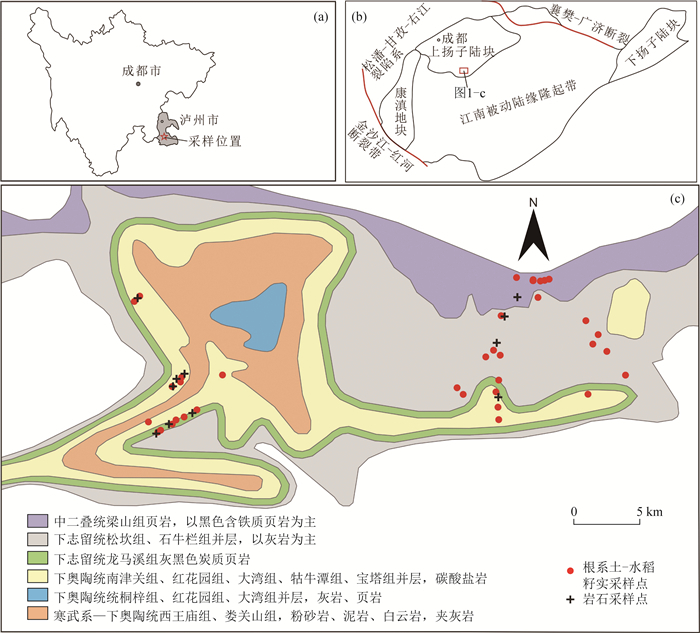
 下载:
下载:

